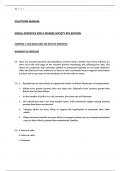1|Page
SOLUTIONS MANUAL
SOCIAL STATISTICS FOR A DIVERSE SOCIETY 9TH EDITION
CHAPTER 1: THE WHAT AND THE WHY OF STATISTICS
ANSWERS TO EXERCISES
C1. Once our research question, the hypothesis, and the study variables have been selected, we
move on to the next stage of the research process--measuring and collecting the data. The
choice of a particular data collection method or instrument depends on our study objective.
After our data have been collected, we have to find a systematic way to organize and analyze
our data and set up some set of procedures to decide what we mean.
C2. a. Republicans are more likely to support the border wall than Democrats or Independents.
b. Whites have greater incomes than any other race. Hispanics have incomes greater than
Blacks but less than Whites.
c. As the number of police in a city increases, the crime rate will decrease.
d. Life satisfaction may vary with marital status, with satisfaction higher among married
persons than those not married.
e. Younger adults are more likely to support the legalization of marijuana than older
adults.
f. Ethnic minority families are more likely to arrange in-home care (vs. formal institutional
care) for their elderly parents than nonminority families.
C3. a. Interval–ratio
b. Interval–ratio
c. Nominal
,2|Page
d. Ordinal
e. Nominal
f. Interval–ratio
g. Ordinal
C4. a. Discrete
b. Continuous
c. Continuous
C5. There are many possible variables from which to choose. Some of the most common
selections by students will probably be: type of occupation or industry, work experience, and
educational training or expertise. Students should first address the relationship between
these variables and gender. Student may also consider measuring structural bias or
discrimination.
C6. a. Unemployment records could be used to determine the actual number of unemployed; a
descriptive statistic based upon the population.
b. A survey is taken to estimate student opinions about the quality of food; inferential
statistic.
c. National health records can be used to determine the incidence rate of breast cancer
among all Asian women, so this would be a descriptive statistic.
d. The ratings will be gathered from a survey, so this is inferential.
e. A university should be able to report GPA by major, so this is a descriptive statistic
based upon the population.
f. In theory, the United States records all immigrants to this country. Therefore, the
number of South East Asian immigrants would be a descriptive statistic. However,
because of illegal immigration, surveys are also taken to estimate the total number of
legal and unauthorized immigrants. In that event, the number of immigrants would be
an inferential statistic.
C7. a. Annual income
,3|Page
b. Gender--nominal; Number of hours worked per week--interval ratio; Years of education--
interval ratio; Job title--nominal.
c. This is an application of inferential statistics. The researcher is using information based on
her sample to predict the annual income of a larger population of young graduates.
C8. At the nominal level, a simple measure of political participation is whether or not someone
voted in the most recent general election. This variable would be coded either “yes” or “no.”
At the ordinal level, a composite measure could be constructed of both voting and political
party membership, like this:
Behavior Code
Didn’t vote, no membership 0
Voted, no membership OR 1
Membership, didn’t vote
Voted and membership 2
These codes are ordinal in scale because the amount of political participation can be ranked
from high to low. Other possible ordinal variables can be constructed from other sets of
behaviors, such as working in a candidate’s campaign and signing a petition. The key points
are to create a variable whose values can be ranked and whose values are not on an interval–
ratio scale.
At the interval–ratio level, political participation could be measured by the percentage of
elections in which a person has voted since becoming eligible to vote, or the amount of
money a person donated to political candidates during some specified time period.
, 4|Page
C9.
Individual age: This variable could be measured as an interval–ratio variable, with actual age in
years reported. As discussed in the chapter, interval–ratio variables are the highest level of
measurement and can also be measured at ordinal or nominal levels.
Annual income: This variable could be measured as an interval–ratio variable, with actual dollar
earnings reported.
Religiosity: This variable could be measured in several ways. For example, as church attendance,
the variable could be ordinal (number of times attended church in a month: every week, at least
twice a month, less than two times a month, none at all).
Student performance: This could be measured as an interval–ratio variable as GPA or test score.
Social class: This variable is an ordinal variable, with categories low, working, middle, and
upper.
Number of children: This variable could be measured in several ways. As an interval–ratio
measure, the actual number of children could be reported. As an ordinal measure, the number of
children could be measured in categories: 0, 1–2, 3–4, 5, or more. This could also be a nominal
measurement--do you have children? Yes or No.
SPSS Solutions
Answers will vary.
Excel Solutions
Answers will vary.




